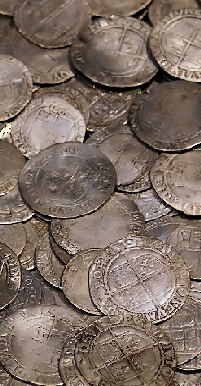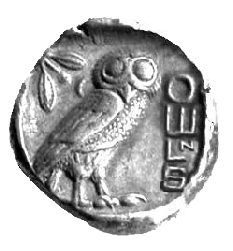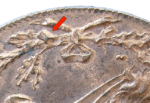
● Next Meeting Status:
Cancelled



● Host Society for the
BANS 2011 Congress
held in Southport


Where to next?

The Anglesey Halfpenny of 1790 by Matthew Boulton
The World’s First Modern Coin
Whilst the first copper token of the industrial revolution was, of course, the Halsall Penny, possibly by Matthew Boulton, which was struck to pay the workers at Colonel Mordaunt’s cotton mill, it is also true that the first copper tokens to be widely circulated were the Anglesey Druids made by Thomas Williams for his Parys Mine Company.

Starting with pennies in 1787, and with the addition of halfpennies in 1788, a torrent
of copper made the face of the Druid one of the best-

But although these dates, 1787, 1788, 1789 and 1791, are well-
This note will look at the 1790 halfpence, struck at Soho by Matthew Boulton, which have the distinction of being the world’s first truly modern coins, fully round and of regular size and weight, struck by steam, in a collar.

Boulton had taken over production of Druid halfpence in 1789 when, for a number of
reasons, not all of them creditable, Thomas Williams decided to cease operation of
his own Parys Mine Mint in Great Charles Street, Birmingham. Boulton had purchased
the presses used by Williams, more to suppress them than because of any use they
might have been, but he continued to use dies engraved with the now-
But Boulton preferred, unsurprisingly, to have all the aspects of coin production
under his own control, and therefore he commissioned his newly-

As, indeed, it was, but it was not done quickly, and by the middle of October 1790 Williams was protesting to Boulton that ‘I am more disappointed than I can express that I have not yet got any Coins from you.’
Dumarest was not the only factor in the delay, however; in addition to developing a new style for the Anglesey coinage, Boulton and his technicians were working on a radical improvement to the way in which his mint operated. The Macclesfield, Cronebane and Anglesey tokens of 1789 had all been struck on steam powered presses, at Soho, but they had all been struck on edge marked blanks without the use of a collar. Boulton’s original collar mechanism, the six segment ‘plateau’ invented by Droz, was unsatisfactory for large scale coin production, and had been abandoned for all except proofs and patterns. The 1789 coins were, therefore, a kind of hybrid, struck by steam but on blanks which expanded at random on striking, in just the same fashion as coins struck on hand presses. They were not truly round, and the edges bulged. They were far short of the great leap forward towards which Boulton was aiming.

But on the second Tuesday in October 1790 (the twelfth) Boulton’s records show that success was achieved with the use of a one piece collar, which produced coins truly round, and with an edge precisely at right angles to the surface. The trial pieces produced were Anglesey halfpennies, with Dumarest’s new Druid, and a standard reverse type but dated 1790. The surviving examples show various aspects of the process, including a unique specimen where the collar mechanism has not operated.
At some point between 25th and 30th October, a box of the new pattern Druids (DH380) was sent to Williams, as on 31st October, his pen dipped in vitriol, Williams replied: ‘I am sorry to tell you we sho’d be abused for Issuing a large quantity from this die…it is universally condemned for being not in Character and out of proportion, the face being much too large for the rest of the head which some Critics say is in so small a compass it admits no room for Brains.’

Much more likely is that the most significant problem with the new-
‘In short, the old Druid by Hancock is so far beyond anything since produced nothing else is well rec’d and unless we can adhere to that Style & Character I w’d rather give up the Coinage entirely than continue it otherwise.’
Against opposition of this nature, Boulton could not prevail, and a slightly later pattern shows the Hancock Druid paired with a 1790 reverse. (DH378) It was this combination which was repeated on the circulation issues dated 1791. Dumarest, having produced a magnificent obverse in his own style, was reduced to engraving the oak wreaths around Hancock’s Druid.

There is, however, one additional feature which makes the 1790 halfpenny so interesting. Boulton had, apparently, experienced problems with some of the earlier Anglesey dies becoming defaced, because of a twist which was imparted to the die as it descended on to the blank. Matthew Boulton had referred, in a letter of 16th July 1790 to James Watt, that the ‘…press makes the ground of a better pollish & will make a few specimens more beautiful, yet it will take from the beauty of a fine Die more than it will add when Tons are to be struck. Such was the Case in the Anglesey pieces I struck for Wms' [presumably the 1789s] 'and was the Cause of Complaints because the Mat of the head was soon pollished off & I am persuaded the beauty of the Engraving will be much better preserved without the twist than with it…’

At least one of the surviving examples clearly shows on the obverse, in what may be an extreme example, how the metal has dragged on one side, indicating that the die was twisting about its axis as the coin was struck. Other examples show little or no twist. Boulton goes on to describe '..if a very small twist is wanted it may be given to the round Bolt..' Examples of the 1789 coinages can be found with traces of twist, but it seems as though this process was abandoned after the 1790 experiments
So, 1790 was a time of both success and frustration for Boulton as far as the Anglesey coinage was concerned. A small part of the frustration was mitigated the following year, when the second of Dumarest’s Druid dies, referred to earlier, was used as the obverse for the Cornish Metal Company halfpennies produced for Boulton’s associate John Vivian.
But while Williams’ rejection of Dumarest’s Druid is a matter of historical record, the fairness, reason, or good taste of the matter is for the reader to decide. Personally, I think that Dumarest’s obverse has far greater presence and that Williams allowed personal animus to cloud his judgement. Put a Dumarest Druid among a group of Hancock Druids and it towers above them.
Chris Leather


Hover your cursor to
see the coins in detail
Dalton & Hamer Anglesey 9
Probably among the first to be struck at Thomas Williams’ works at Holywell


Obverse and Reverse of an Anglesey Halfpenny of 1789 showing the Druid engraved by John Hancock
Obverse and Reverse of Boulton’s pattern Halfpenny of 1790 showing the Druid engraved by Rambert Dumarest


With Collar Without Collar
Dalton & Hamer Anglesey 380
Pattern Halfpence of 1790


● For more information about Matthew Boulton and the Soho Mint, why not visit www.sohomint.info which has been established as a resource for collectors and students, to commemorate the bicentenary of the death of the great man. Just click on the link!
Acknowledgement
My thanks go to Bill McKivor of the Copper Corner, Seattle, for permission to use the illustrations indicated by Bill’s favourite skating parson!


Obverse and Reverse of Boulton’s Halfpenny of 1791 showing the Druid engraved by Hancock and wreath engraved by Rambert Dumarest

Section of Obverse of DH380,
Dumarest's Druid, showing the effect of the twist given by the press


Obverse and Reverse of
Cornish Halfpenny 1791
showing the second of Dumarest's Druids


